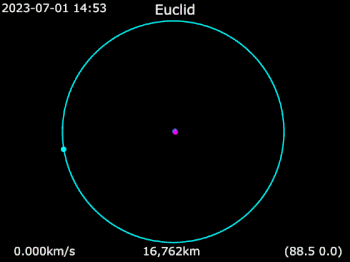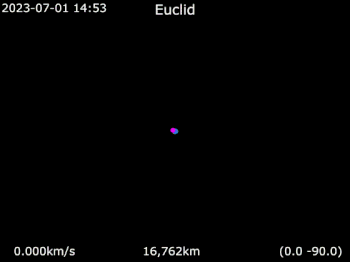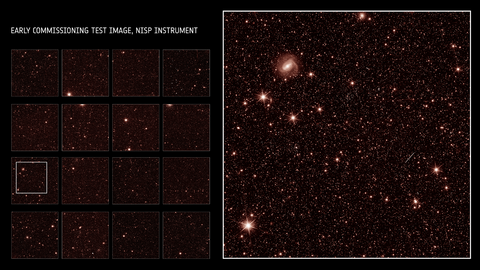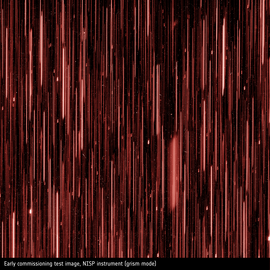Euclid (spacecraft)
This article has multiple issues. Please help improve it or discuss these issues on the talk page. (Learn how and when to remove these messages)
|
 Artist's impression | |||||||
| Names | Dark Universe Explorer (DUNE) Spectroscopic All Sky Cosmic Explorer (SPACE)[1] | ||||||
|---|---|---|---|---|---|---|---|
| Mission type | Astronomy | ||||||
| Operator | ESA | ||||||
| COSPAR ID | 2023-092A | ||||||
| SATCAT no. | 57209 | ||||||
| Website | sci.esa.int/euclid euclid-ec.org | ||||||
| Mission duration | 6 years (nominal) 1 year, 6 months and 7 days (in progress)[2] | ||||||
| Spacecraft properties | |||||||
| Manufacturer | Thales Alenia Space (main) Airbus Defence and Space (payload module)[3] | ||||||
| Launch mass | 2,000 kg (4,400 lb)[3] | ||||||
| Payload mass | 800 kg (1,800 lb)[3] | ||||||
| Dimensions | 4.5 × 3.1 m (15 × 10 ft)[3] | ||||||
| Start of mission | |||||||
| Launch date | 1 July 2023, 15:12 UTC[4] | ||||||
| Rocket | Falcon 9 | ||||||
| Launch site | Cape Canaveral, SLC‑40 | ||||||
| Contractor | SpaceX | ||||||
| Orbital parameters | |||||||
| Reference system | Sun–Earth L2[3] | ||||||
| Regime | Lissajous orbit | ||||||
| Periapsis altitude | 1,150,000 km (710,000 mi) | ||||||
| Apoapsis altitude | 1,780,000 km (1,110,000 mi) | ||||||
| Epoch | Planned | ||||||
| Main telescope | |||||||
| Type | Korsch telescope | ||||||
| Diameter | 1.2 m (3 ft 11 in)[5] | ||||||
| Focal length | 24.5 m (80 ft)[5] | ||||||
| Collecting area | 1.006 m2 (10.83 sq ft)[8] | ||||||
| Wavelengths | From 550 nm (green)[6] to 2 μm (near-infrared)[7] | ||||||
| Resolution | 0.1 arcsec (visible) 0.3 arcsec (near-infrared)[8] | ||||||
| Transponders | |||||||
| Band | X band (TT&C support) K band (data acquisition) | ||||||
| Frequency | 8.0–8.4 GHz (X band) 25.5–27 GHz (K band) | ||||||
| Bandwidth | Few kbit/s down & up (X band) 74 Mbit/s (K band)[9] | ||||||
| |||||||
 The ESA astrophysics insignia for Euclid mission | |||||||
Euclid is a wide-angle space telescope with a 600-megapixel camera to record visible light, a near-infrared spectrometer, and photometer, to determine the redshift of detected galaxies. It was developed by the European Space Agency (ESA) and the Euclid Consortium and was launched on 1 July 2023 from Cape Canaveral in Florida.[10][11]
After approximately one month, it reached its destination, a halo orbit around the Sun-Earth second Lagrange point L2, at an average distance of 1.5 million kilometres beyond Earth's orbit (or about four times the distance from the Earth to the Moon). There the telescope is expected to remain operational for at least six years. It joins the Gaia and James Webb Space Telescope missions at L2.
The objective of the Euclid mission is to better understand dark energy and dark matter by accurately measuring the accelerating expansion of the universe. To achieve this, the Korsch-type telescope will measure the shapes of galaxies at varying distances from Earth and investigate the relationship between distance and redshift. Dark energy is generally accepted as contributing to the increased acceleration of the expanding universe, so understanding this relationship will help to refine how physicists and astrophysicists understand it. Euclid's mission advances and complements ESA's Planck telescope (2009 to 2013). The mission is named after the ancient Greek mathematician Euclid.
Euclid is a medium-class ("M-class") mission and is part of the Cosmic Vision campaign of ESA's Science Programme. This class of missions have an ESA budget cap at around €500 million. Euclid was chosen in October 2011 together with Solar Orbiter, out of several competing missions.[12] Euclid was launched by a Falcon 9.[13][4]
On 7 November 2023 ESA revealed Euclid's first full-colour images of the cosmos. The telescope has created razor-sharp astronomical images across a large patch of the sky, looking far into the distant universe. The first five images illustrate Euclid's full potential to create the most extensive 3D map of the universe yet.[14][15]
In May 2024, ESA's Euclid mission released images of galaxy clusters Abell 2390 and Abell 2764, star-forming region Messier 78, spiral galaxy NGC 6744, and the Dorado group of galaxies. These early observations demonstrate Euclid's capability to study dark matter and cosmic evolution.[16]
Scientific objectives and methods
[edit]Euclid will probe the history of the expansion of the universe and the formation of cosmic structures by measuring the redshift of galaxies out to a redshift value of 2, which is equivalent to seeing back 10 billion years into the past.[17] The link between galactic shapes and their corresponding redshift will help to show how dark energy contributes to the increased acceleration of the universe. The methods employed exploit the phenomenon of gravitational lensing, measurement of baryon acoustic oscillations, and measurement of galactic distances by spectroscopy.[18]
Gravitational lensing (or gravitational shear) is a consequence of the deflection of light rays caused by the presence of matter that locally modifies the curvature of space-time: light emitted by galaxies, and therefore observed images, are distorted as they pass close to matter lying along the line of sight. This matter is composed partly of visible galaxies but it is mostly dark matter. By measuring this shear, the amount of dark matter can be inferred, furthering the understanding of how it is distributed in the universe.[19]
Spectroscopic measurements will permit measuring the redshifts of galaxies and determining their distances using Hubble's law. In this way, one can reconstruct the three-dimensional distribution of galaxies in the universe.[17]
From these data, it is possible to simultaneously measure the statistical properties concerning the distribution of dark matter and galaxies and measure how these properties change as the spacecraft looks further back in time. Highly precise images are required to provide sufficiently accurate measurements. Any distortion inherent in the sensors must be accounted for and calibrated out, otherwise the resultant data would be of limited use.[17]
Spacecraft
[edit]
Euclid emerged from two mission concepts that were proposed in response to the ESA Cosmic Vision 2015–2025 Call for Proposals, issued in March 2007: DUNE, the Dark Universe Explorer, and SPACE, the Spectroscopic All-Sky Cosmic Explorer. Both missions proposed complementary techniques to measure the geometry of the universe, and after an assessment study phase, a combined mission resulted. The new mission concept was called Euclid, honouring the Greek mathematician Euclid of Alexandria (~300 BC), who is considered the father of geometry. In October 2011, Euclid was selected by ESA's Science Programme Committee for implementation, and on 25 June 2012 it was formally adopted.[1]
ESA selected Thales Alenia Space's Italian division for the construction of the satellite in Turin. Euclid is 4.5 metres long with a diameter of 3.1 metres and a mass of 2 tonnes.[3]
Meanwhile, the Euclid payload module was the responsibility of Airbus Defence and Space's French division in Toulouse. It consists of a Korsch telescope with a primary mirror 1.2 meters in diameter, which covers an area of 0.91 deg2.[20][21]
An international consortium of scientists, the Euclid consortium, comprising scientists from 13 European countries and the United States, provided the visible-light camera (VIS)[6] and the near-infrared spectrometer and photometer (NISP).[7] Together, they will map the 3D distribution of up to two billion galaxies spread over more than a third of the whole sky.[22] These large-format cameras will be used to characterise the morphometric, photometric, and spectroscopic properties of galaxies.
Instruments
[edit]- VIS, a camera operating at visible wavelengths (530–920 nm), made of a mosaic of 6 × 6 e2v charge coupled detectors, containing 600 million pixels, allows measurement of the deformation of galaxies[23]
- NISP, a camera composed of a mosaic of 4 × 4 Teledyne H2RG detectors sensitive to near-infrared light radiation (920–2020 nm) with 65 million pixels, is designed for the following:
- provide low-precision measurements of redshifts, and thus distances, of over a billion galaxies from multi-color (3-filter (Y, J and H)) photometry (photometric redshift technique); and
- use a slitless spectrometer to analyse the spectrum of light in near-infrared (920–1850 nm), to acquire precise redshifts and distances of millions of galaxies with an accuracy 10 times better than photometric redshifts, and to determine the baryon acoustic oscillations.[24]
Spacecraft bus
[edit]

The telescope bus includes solar panels that provide power and stabilise the orientation and pointing of the telescope to better than 35 milliarcseconds (170 nrad). The telescope is carefully insulated to ensure good thermal stability so as to not disturb the optical alignment.[citation needed]
The telecommunications system is capable of transferring 850 gigabits per day. It uses the Ka band and CCSDS File Delivery Protocol to send scientific data at a rate of 55 megabits per second during the allocated period of 4 hours per day to the 35 m dish Cebreros ground station in Spain, when the telescope is above the horizon. Euclid has an onboard storage capacity of 4 terabits (500 GB).[25]
The service module (SVM) hosts most of the spacecraft subsystems:[citation needed]
- TT&C – Telemetry and Telecommand
- AOCS – Attitude Orbit Control System
- CDMS – Central Data Management System
- EPS – Electrical Power System
- RCS – Reaction Control System
- MPS – Micro-Propulsion System
AOCS provides stable pointing with a dispersion beneath 35 milli-arcseconds per visual exposure. A high thermal stability is required to protect the telescope assembly from optical misalignments at those accuracies.[26]
Milestones
[edit]NASA signed a memorandum of understanding with ESA on 24 January 2013 describing its participation in the mission. NASA provided 20 detectors for the near-infrared band instrument, which operate in parallel with a camera in the visible-light band. The instruments, the telescope, and the satellite were built in and are operated from Europe. NASA has also appointed 40 American scientists to be part of the Euclid consortium, which will develop the instruments and analyse the data generated by the mission. Currently, this consortium brings together more than 1000 scientists from 13 European countries and the United States.[27]
In 2015, Euclid passed a preliminary design review, having completed a large number of technical designs as well as built and tested key components.[28]
In December 2018, Euclid passed its critical design review, which validated the overall spacecraft design and mission architecture plan, and final spacecraft assembly was allowed to commence.[29]
In July 2020, the two instruments (visible and NIR) were delivered to Airbus, Toulouse, France for integration with the spacecraft.[30]
After Russia withdrew in 2022 from the Soyuz-planned launch of Euclid, the ESA reassigned it to a SpaceX Falcon 9 launch vehicle, which launched on 1 July 2023 from Cape Canaveral Space Launch Complex 40.[13][31][11]
Launch, operational orbit, commissioning
[edit]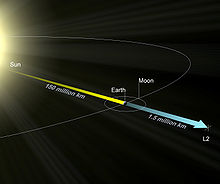
Following a travel time of 30 days after launch, it began to orbit the Sun-Earth Lagrangian point L2[3] in an eclipse-free halo orbit about 1 million km wide.
Upon receiving the initial images, a problem surfaced as scientists discovered a small gap in the spacecraft's hull. This gap allowed sunlight to infiltrate the imaging sensor, resulting in a degradation of image quality.[32] To tackle this issue, the team adjusted the spacecraft's orientation by a few degrees, effectively blocking sunlight from entering the identified gap. This corrective measure successfully resolved the problem.[33]
Data releases
[edit]In May 2024 the Early Release Observations (ERO) was the first published data release.[34] This release contains images and catalogs of star-forming regions, globular clusters, nearby galaxies, fields of the Fornax cluster and Perseus cluster, as well as more distant galaxy clusters.[35] The content of the ERO is described in one paper submitted to Astronomy & Astrophysics. The researchers use a pipeline that can process the images in two ways: optimized for point-sources or optimized for extended sources.[36] A series of papers describe first results from ERO. These include free-floating planetary-mass objects discovered in the Sigma Orionis cluster,[37] discovery of new gravitational lenses,[38] and the discovery of a dwarf satellite galaxy around NGC 6744.[39]
Future Data Releases are the Quick Euclid data release 1 (Q1), planned for 19th March 2025, and the Data Release 1 (DR1), planned for 21st October 2025.[34] Future Euclid Data Releases and the associated data products will likely appear on the same URL as the ERO.[40]
Nominal mission
[edit]
During its nominal mission, which will last at least six years, Euclid will observe about 15,000 deg2 (4.6 sr), about a third of the sky, focusing on the extragalactic sky (the sky facing away from the Milky Way).[2] It will generate approximately 100 gigabytes of compressed data per day throughout its six-year mission.[41] The survey will be complemented by additional observations of three deep fields to 5 times the signal-to-noise of the wide survey; the deep fields cover 50 deg2 (15.2 msr).[42] The three fields will be regularly visited during the whole duration of the mission. They will be used as calibration fields and to monitor the telescope and instrument performance stability as well as to produce scientific data by observing the most distant galaxies and quasars in the universe.[43] Two of the deep fields will overlap with deep fields of existing surveys[44] and the third deep field is proposed as a location for one of the LSST deep drilling fields at the Vera C. Rubin Observatory.[45]
To measure a photometric redshift for each galaxy with sufficient accuracy, the Euclid mission depends on additional photometric data obtained in at least four filters at optical wavelengths. This data will be obtained from ground-based telescopes located in both northern and southern hemispheres to cover the full 15,000 deg2 of the mission.[46][47] In total each galaxy of the Euclid mission will get photometric information in at least seven different filters covering the whole range 460–2000 nm.[48]
About 10 billion astronomical sources will be observed by Euclid, of which one billion will be used for weak lensing (to have their gravitational shear measured)[49] with a precision 50 times more accurate than is possible today using ground-based telescopes. Euclid will measure spectroscopic redshifts for at least 30 million objects to study galaxy clustering.
The scientific exploitation of this enormous data set will be carried out by a European-led consortium of more than 1200 people in over 100 laboratories in 18 countries (Austria, Belgium, Denmark, Finland, France, Germany, Italy, the Netherlands, Norway, Portugal, Romania, Spain, Switzerland, UK, Canada, US, and Japan).[50] The Euclid Consortium[49] is also responsible for the construction of the Euclid instrument payload and for the development and implementation of the Euclid ground segment which will process all data collected by the satellite. The laboratories contributing to the Euclid Consortium are funded and supported by their national space agencies, which also have the programmatic responsibilities of their national contribution, and by their national research structures (research agencies, observatories, universities). Overall, the Euclid Consortium contributes to about 25% of the total budget cost of the mission until completion.[51]
The huge volume, diversity (space and ground, visible and near-infrared, morphometry, photometry, and spectroscopy) and the high level of precision of measurements demanded considerable care and effort in the data processing, making this a critical part of the mission. ESA, the national agencies and the Euclid Consortium are spending considerable resources to set up top-level teams of researchers and engineers in algorithm development, software development, testing and validation procedures, data archiving and data distribution infrastructures. In total, nine Science Data Centres spread over countries of the Euclid Consortium will process more than 170 petabytes of raw input images over at least 6 years to deliver data products (images, catalogues spectra) in three main public data releases in the Science Archive System of the Euclid mission to the scientific community.[52][48]
With its wide sky coverage and its catalogues of billions of stars and galaxies, the scientific value of data collected by the mission goes beyond the scope of cosmology. This database will provide the worldwide astronomical community with abundant sources and targets for the James Webb Space Telescope and Atacama Large Millimeter Array, as well as future missions such as the Extremely Large Telescope, Thirty Meter Telescope, Square Kilometer Array, and the Vera C. Rubin Observatory.[53]
Gallery of first test images
[edit]-
Euclid scans across the night sky using a "step-and-stare" method, combining separate measurements to form the largest cosmological survey ever conducted in the visible and near-infrared.
-
Early commissioning test image VIS instrument
-
Early commissioning test image NISP instrument
-
Early commissioning test image NISP instrument grism mode
Source:[54]
Gallery
[edit]-
Euclid's view of the Horsehead Nebula.
-
Euclid's view of the Perseus cluster of galaxies.
-
Euclid's view of galaxy cluster Abell 2390.
-
Euclid's view of spiral galaxy NGC 6744.
-
Euclid's view of galaxy cluster Abell 2764.
-
Euclid's view of star-forming region Messier 78.
-
The mosaic and zoomed in images released by ESA’s Euclid mission on 15 October 2024[55]
-
Barnard 30 with Euclid
References
[edit]- ^ a b "Euclid overview". esa.int.
- ^ a b "Mission Characteristic – Euclid Consortium". Euclid Consortium. 28 December 2015. Archived from the original on 16 March 2022. Retrieved 26 April 2016.
- ^ a b c d e f g "FACT SHEET". euclid. ESA. 24 January 2023. Retrieved 7 July 2023.
- ^ a b "Falcon 9 Block 5 – Euclid Telescope". Next Spaceflight. 5 June 2023. Retrieved 5 June 2023.
- ^ a b "Euclid Spacecraft – Telescope". ESA. 24 January 2013. Retrieved 13 April 2011.
- ^ a b c "Euclid VIS Instrument". ESA. 18 October 2019. Retrieved 9 July 2020.
- ^ a b c "Euclid NISP Instrument". ESA. 19 September 2019. Retrieved 9 July 2020.
- ^ a b "Euclid – Mapping the geometry of the dark Universe". ESA Earth Observation Portal. Archived from the original on 5 January 2022. Retrieved 5 January 2022.
- ^ "Follow Euclid's first months in space".
- ^ Miller, Katrina (1 July 2023). "The Dark Universe Is Waiting. What Will the Euclid Telescope Reveal? – The European Space Agency mission, which launched on Saturday, will capture billions of galaxies to create a cosmic map spanning space and time". The New York Times. Archived from the original on 1 July 2023. Retrieved 2 July 2023.
- ^ a b "Euclid successfully launched into space by Falcon 9 rocket". Interesting Engineering. 1 July 2023. Retrieved 1 July 2023.
- ^ "Mission Status". European Space Agency. Retrieved 23 November 2015.
- ^ a b Foust, Jeff (20 October 2022). "ESA moves two missions to Falcon 9". SpaceNews. Retrieved 20 October 2022.
- ^ Miller, Katrina (7 November 2023). "Euclid Telescope Dazzles With Detailed First Images of Our Universe - The European Space Agency's premier telescope captured new views of space, a small taste of what it is likely to accomplish in the coming years". The New York Times. Archived from the original on 7 November 2023. Retrieved 8 November 2023.
- ^ "Euclid's first images: The dazzling edge of darkness".
- ^ "ESA's Euclid celebrates first science with sparkling cosmic views". www.esa.int. Retrieved 23 May 2024.
- ^ a b c "ESA Science & Technology – Science Goals". sci.esa.int.
- ^ "ESA Science & Technology – What are baryonic acoustic oscillations?". sci.esa.int.
- ^ "ESA Science & Technology – What is gravitational lensing?". sci.esa.int.
- ^ "ESA Science & Technology – Payload Module". sci.esa.int.
- ^ "ESA Science & Technology – Telescope". sci.esa.int.
- ^ "Thales Alenia Space kicks off Euclid construction". esa.int. 8 July 2013.
- ^ "ESA Science & Technology – Euclid VIS instrument". sci.esa.int.
- ^ "ESA Science & Technology – Euclid NISP instrument". sci.esa.int.
- ^ "Euclid launch kit" (PDF). European Space Agency. p. 7. Retrieved 24 May 2024.
- ^ "ESA Science & Technology – Service Module". sci.esa.int.
- ^ "La NASA participará en la misión de la ESA para estudiar el lado oscuro del Universo". esa.int (in Spanish). 24 January 2013.
- ^ "Euclid dark Universe mission ready to take shape". ESA. 17 December 2015. Retrieved 17 December 2015.
- ^ "Arianespace and ESA announce the Euclid satellite's launch contract for dark energy exploration". esa.int. 7 January 2020.
- ^ "The Euclid space telescope is coming together". Space Daily.
- ^ ESA Euclid Mission, July 2023, retrieved 1 July 2023
- ^ Quach, Katyanna. "ESA's Euclid telescope beams back first test images". www.theregister.com. Retrieved 16 November 2023.
- ^ Sullivan, Will. "See the First Stunning Test Images From the Euclid Space Telescope". Smithsonian Magazine. Retrieved 16 November 2023.
- ^ a b "Timeline - Euclid - Cosmos". Euclid. Retrieved 9 January 2025.
- ^ "Euclid Early Release Observations". euclid.esac.esa.int. Retrieved 9 January 2025.
- ^ Cuillandre, J. -C.; Bertin, E.; Bolzonella, M.; Bouy, H.; Gwyn, S.; Isani, S.; Kluge, M.; Lai, O.; Lançon, A. (1 May 2024). "Euclid: Early Release Observations -- Programme overview and pipeline for compact- and diffuse-emission photometry". arXiv:2405.13496 [astro-ph].
- ^ Martín, E. L.; {Ž}erjal, M.; Bouy, H.; Martin-Gonzalez, D.; Mu{ň}oz Torres, S.; Barrado, D.; Olivares, J.; Pérez-Garrido, A.; Mas-Buitrago, P. (1 May 2024). "Euclid: Early Release Observations -- A glance at free-floating new-born planets in the sigma Orionis cluster". arXiv:2405.13497 [astro-ph].
- ^ Acevedo Barroso, J. A.; O'Riordan, C. M.; Clément, B.; Tortora, C.; Collett, T. E.; Courbin, F.; Gavazzi, R.; Metcalf, R. B.; Busillo, V. (1 August 2024). "Euclid: The Early Release Observations Lens Search Experiment". arXiv:2408.06217 [astro-ph].
- ^ Hunt, L. K.; Annibali, F.; Cuillandre, J. -C.; Ferguson, A. M. N.; Jablonka, P.; Larsen, S. S.; Marleau, F. R.; Schinnerer, E.; Schirmer, M. (1 May 2024). "Euclid: Early Release Observations -- Deep anatomy of nearby galaxies". arXiv:2405.13499 [astro-ph].
- ^ "Euclid SOC". euclid.esac.esa.int. Retrieved 9 January 2025.
- ^ "Euclid calling: downloading the Universe". www.esa.int. Retrieved 16 November 2023.
- ^ "Three Dark Fields for Euclid's Deep Survey". ESA. 12 June 2019. Retrieved 11 December 2022.
- ^ "Surveys". Euclid Consortium. Retrieved 5 August 2023.
- ^ "Three Dark Fields for Euclid's Deep Survey". ESA. 12 June 2019. Retrieved 8 January 2024.
- ^ "SCOC endorsement of Euclid Deep Field South observations". Vera C. Rubin Observatory. 23 March 2022. Retrieved 8 January 2024.
- ^ Racca, Giuseppe D.; et al. (2016). "The Euclid mission design". In MacEwen, Howard A.; Fazio, Giovanni G.; Lystrup, Makenzie; Batalha, Natalie; Siegler, Nicholas; Tong, Edward C. (eds.). Space Telescopes and Instrumentation 2016: Optical, Infrared, and Millimeter Wave. Vol. 9904. pp. 99040O. arXiv:1610.05508. doi:10.1117/12.2230762. S2CID 118513194.
- ^ Poncet, Maurice; Dabin, Christophe; Buenadicha, Guillermo; Hoar, John; Zacchei, Andrea; Sauvage, Marc (2018). "Euclid Science Ground Segment (SGS) Processing Operations Concept". 2018 SpaceOps Conference. doi:10.2514/6.2018-2433. ISBN 978-1-62410-562-3.
- ^ a b "Euclid – Mapping the Geometry of the Dark Universe Mission".
- ^ a b "Euclid Consortium – A space mission to map the Dark Universe".
- ^ "About the Euclid Consortium and membership". Euclid Consortium. 15 April 2023. Retrieved 3 July 2023.
- ^ "Spaceflight Now | Breaking News | ESA's Euclid mission cleared to proceed into development".
- ^ "Panoramic Information Euclid Space Telescope: Unveiling the Secrets of the Dark Universe day 03/07/2023 – Reportdome". 3 July 2023. Archived from the original on 21 July 2023. Retrieved 7 July 2023.
- ^ "ESA Science & Technology – Legacy science (beyond cosmology)". sci.esa.int.
- ^ "Euclid test images tease of riches to come". www.esa.int. Retrieved 31 July 2023.
- ^ "Zoom into the first page of ESA Euclid's great cosmic atlas". www.esa.int. Retrieved 22 October 2024.

